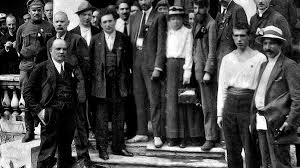- M.N. Roy (Manabendra Nath Roy), Virendranath Chattopadhyay, and Abani Mukherjee played significant roles in introducing communist ideology to India, although their activities were largely outside India.
- M.N. Roy was a co-founder of Marxism-Leninism in India and the Communist Party of Mexico in 1919. He was also a member of the Comintern (Communist International), and his efforts laid the ideological foundation for communism in India.
- Virendranath Chattopadhyay (known as Chatto) was a revolutionary nationalist and socialist who worked with international communist movements.
- Abani Mukherjee was involved in Marxist activities abroad and helped spread communist ideas among Indian expatriates.
- The Communist Party of India (CPI) was formally established in Kanpur, Uttar Pradesh, during a conference held in December 1925.
- The conference was organized by Satyabhakta, a left-wing Congressman and Marxist advocate, although disagreements emerged between him and other Marxists, as he favored a more nationalist approach to communism.
- M.N. Roy, though not present at the Kanpur conference, exerted significant influence through his writings and activities.
- Before the formal establishment of the CPI in Kanpur, communist activities were sporadic and often inspired by international socialist movements.
- Publications such as The Socialist by S.A. Dange and the activities of the Ghadar Party contributed to the spread of Marxist ideas in India.
- The Kanpur conference marked the formal beginning of a unified communist movement in India.
- It aimed to organize workers and peasants and emphasized anti-colonial struggles and social justice.
- The CPI played a significant role in Indian politics, particularly in labor movements and the fight for independence. It later became a major political force post-independence.
- M.N. Roy, Virendranath Chattopadhyay, and Abani Mukherjee were pioneers in spreading Marxist ideas among Indians, largely through international efforts.
- The Communist Party of India was formally established in December 1925 at the Kanpur conference, with key figures such as S.A. Dange and Muzaffar Ahmed.
- This event marked the beginning of a structured communist movement within India, influenced by both domestic and international Marxist ideologies.







